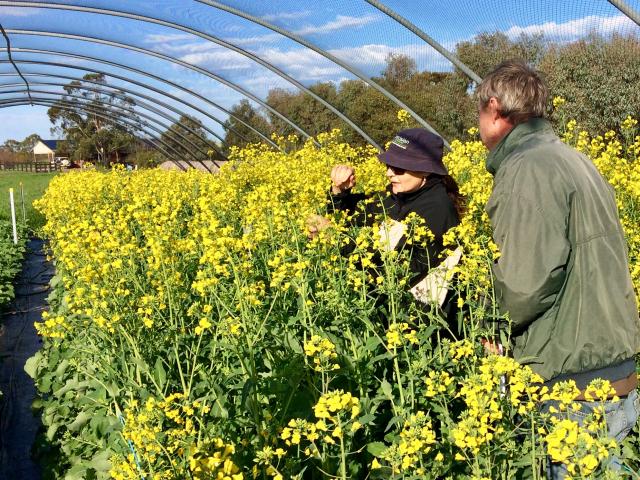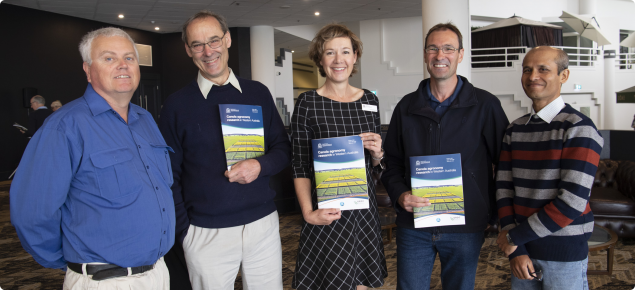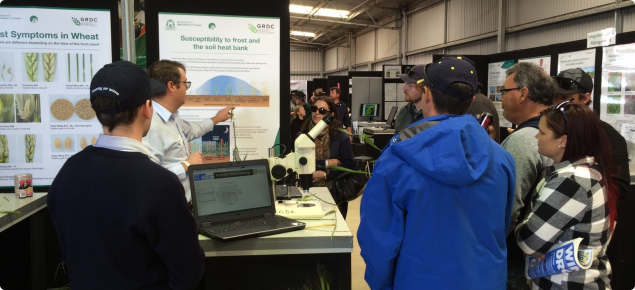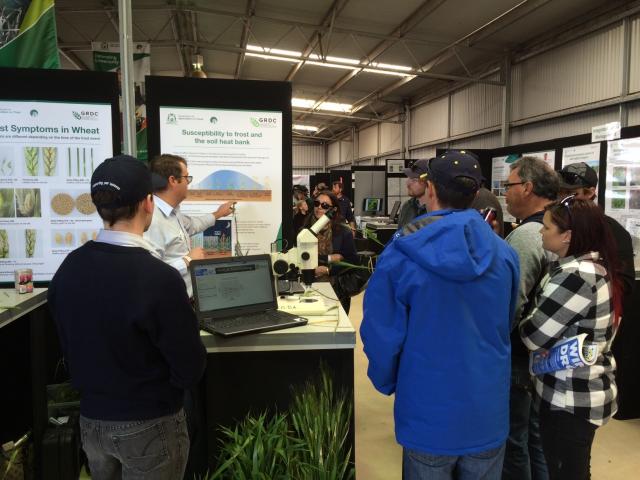In this edition...
Pre-harvest protection
With harvest fast approaching there is a narrowing window for weed, pest and disease management before the season ends.
New canola publication valuable reference for growers
A new publication, 'Canola agronomy research in Western Australia’, is now available for canola growers and agronomists to access the latest research to assist them in making decisions about their canola crops for the 2019 season and beyond.
Frost resources available to assist growers
DPIRD has a range of resources available to assist growers to assess frost damage in crops and evaluate subsequent management strategies and options.
Canola growers input sought for online survey
Canola growers are being asked to complete a survey to find out how on-farm canola practices have changed in the last two decades.
Pre-harvest protection
With harvest fast approaching there is a narrowing window for weed, pest and disease management before the season ends.
Crop topping, swathing (with or without an additional spray application) plus crop desiccation or pre-harvest spraying remain useful options for spring management.
Always check for changes to registrations and rates of applications for any chemical to be applied at this late crop stage.
Also, grain receival standards need to be adhered to when delivering grain to CBH and other grain marketing organisations.
Swathing and spraying canola
While the seed set control of weeds can be an added bonus of swathing and dessication, the timing of these operations to optimise grain yield and oil content of canola can be a challenge.
Department of Primary Industries and Regional Development (DPIRD) officer Glen Riethmuller conducted a number of experiments in Katanning and Mt Barker, from 2010-2013, on the effects of desiccation, swathing and pre-harvest spraying on annual ryegrass seed viability and canola yield and oil parameters.
He found that the viability of annual ryegrass seed can be reduced substantially by desiccation, pre-harvest spraying or swathing of canola depending on the product and timing.
For more information refer to the Protecting WA crops – pre-harvest protection webpage.
For the complete details and results from this research, refer to Glen’s 2017 Research Update paper Annual ryegrass viable seed reduced by dessication and swathing canola.
Crop topping
Crop topping (the late application of herbicides to prevent weed seed-set) can be used for managing herbicide resistance, as a late post-emergent salvage treatment or to control any weeds that survived or were missed in other weed management strategies.
Late weed control may also reduce grain contamination but a crop-topping application will not increase grain yield.
There are paraquat and glyphosate products (read the label) registered for crop-topping in WA but these are limited for use in pulse crops and predominantly target annual ryegrass.
For further information on best timing for weed management while limiting potential impacts on the crop refer to Crop topping pulse crops.
Early control of summer weeds
Control of summer weeds is best done when the weeds are small – particularly those weeds that may be difficult to manage as they age or when growing conditions are challenging (hot, dry and dusty).
Many of our summer weeds, like Fleabane, will germinate in late spring following rains at harvest.
Take the time during the harvest operation to identify paddocks and other areas where summer weeds are germinating and then return to these paddocks following harvest to control the seedlings.
For more information on summer weeds and their control see the Summer weeds webpage.
Information is also available on the management of wild radish, green radish, ergot and grain contamination.
The next Protecting WA Crops newsletter will soon be published, subscribe now so you don’t miss out!
New canola publication valuable reference for growers

Canola growers and agronomists can access the latest canola research to assist them in making decisions about their canola crops for the 2019 season and beyond.
A new publication released by the Department of Primary Industries and Regional Development (DPIRD) the ‘Canola agronomy research in Western Australia’ bulletin provides an overview of 19 research activities currently being undertaken by the department and the CSIRO, with support from the Grains Research and Development Corporation (GRDC).
This bulletin harnesses five years of canola agronomy research from over 110 field trials undertaken by DPIRD researchers and partners throughout the grainbelt, from Geraldton to Esperance.
The publication profiles canola research across the production spectrum, including early sowing opportunities, variety analysis, plant density, using retained seed, fertiliser timing and rates, weed and pest management and grazing strategies.
It will prove to be a valuable reference for growers and agronomists to enhance crop management strategies to improve grain yields, quality and returns.
The bulletin provides an easy-to-read summary of the department’s canola research program, which spans pre-seeding, seeding, nutrition and in-crop work, supported by graphs and images of results.
The bulletin will be sent to growers in the next edition of the GRDC’s GroundCover magazine. It can also be downloaded from the department’s website.
Canola growers are being asked to complete a survey to find out how on-farm canola practices have changed in the last two decades. Read the article ‘Canola growers input sought for online survey’ to find out more or complete the survey.
Frost resources available to assist growers
The Department of Primary Industries and Regional Development (DPIRD) has a range of resources available to assist growers to assess crops and evaluate subsequent management strategies and options on its ‘2018 Frost Trials and Seasonal Information’ webpage.
The ‘Frost Identification Guide for Cereals’, produced by the department with co-investment from the Grains Research and Development Corporation (GRDC), features several high resolution photographs and clear explanations to diagnose frost damage in wheat, barley and oats.
Fortnightly frost incidence maps are also available via the webpage, along with a comprehensive Frequently Asked Questions brochure.
Minimum temperature information from the department’s network of 175 weather stations across the State is also available for free from the department’s recently upgraded online weather pages.
The 2018 Frost Trials and Seasonal Information webpage includes a link to ‘Management options for a frosted crop’.
The department has several frost research projects underway to better understand how frost affects grains crops, with co-investment from GRDC, to help Western Australian grain growers reduce its impact on crops.
In August and September there were a series of frost events throughout the central, eastern and southern Wheatbelt. To help make informed decisions on salvage options that can minimise the impact of frost, refer to the article ‘Hay or Harvest’.
Follow our researchers and partners on Twitter
- Ben Biddulph, Research officer DPIRD @ben_biddulph
- Dion Nicol, Research officer DPIRD @DionNicol_WA
- Brenton Leske, PhD candidate UWA, Research officer @BrentonLeske
- Kelly Ryan, Development officer DPIRD @kelguest83
- Rebecca Smith, Research agronomist based in York @bec_jenkinson
- Facey Group Wickepin @FaceyGroup
- Kelly Angel, Research officer at BCG @kangel62
- ConsultAg @consultAg
Climate resources
Incidence of frost varies strongly across the agricultural region, with greatest occurrence in the central, eastern and southern parts.
DPIRD provides up to date information about the coming season and its potential impacts on cropping and agriculture to assist in making more informed on-farm decisions.
The website provides information on statistical seasonal rainfall forecasts, modelled plant available soil water at the start of the growing season and risk of frost occurring at different locations.
Frost risk maps shows the average number of low temperature events occuring in the months when crops are at most risk of frost damage from 1975-2014.
You can use this map to get a general indication of the likelihood of frost for your area for this season. Historical frost risk maps show the past occurrence of frost risk and these are available from the Seasonal climate information page.
Extreme weather events tool uses data from DPIRD's extensive weather station network to map extreme temperatures, either below or above a specified threshold. It provides real-time information about the location, duration and severity of frost and heat stress events, to help grain growers manage according to reduce their financial impact.
Canola growers input sought for online survey

Canola growers are being asked to complete a survey to find out how on-farm canola practices have changed in the last two decades.
The survey will specifically compare practices in the year 2000 with this year, 2018.
Conducted Australia-wide, the survey will inform researchers of how farming practices have changed and how they may influence disease management for the Australian canola industry.
Blackleg is a common and significant disease of canola and pathologists want to know if you have access to sufficient information to help you manage it. All collected data is anonymous.
The survey is targeted at growers but agribusiness and researchers are also encouraged to complete the survey for their clients/growers they are in contact with.
The survey is being conducted by the national canola pathology project that the Department of Primary Industries and Regional Development (DPIRD) is part of, in collaboration with NSW Department Primary Industries, University of Melbourne, Marcroft Grains Pathology, South Australian Research and Development Institute and CSIRO, Canberra. This project is supported by Grains Research Development Corporation.
It is also available in hardcopy or can be completed over the phone by calling one of the DPIRD canola pathology team..
To complete the survey it would be preferable to have the following details for the years 2000 and 2018 at hand, if possible, or answers can be left blank if unknown:
- canola varieties grown and areas sown
- canola yield, sowing date and flowering date aimed for
- row spacing, cultivation, stubble management methods used
- nitrogen, seed dressing and foliar fungicides applied.
Those who complete the survey have the option of receiving a summary of the survey results which should be of great value for future research.
Canola growers and agronomists can now also access the latest canola research to assist them in making decisions about their canola crops for the 2019 season and beyond. Read the article ‘New canola publication a valuable reference for growers’ to find out more.
For more information contact Ciara Beard, research officer, Geraldton, on 9956 8504, Ravjit Khangura research officer, South Perth, on 9368 3374 or Andrea Hills research officer, Esperance on 9083 1144.





